|
A Week’s
Worth of Chocolate-- I started the year by reading The
Chocolate Touch by Patrick Skene Catling followed by
Charlie and the Chocolate Factory by Roald Dahl. We did a
comparison/contrast using a Venn diagram template with
Kidspiration. Upon completing Charlie and the Chocolate
Factory we studied various character traits of people and
determined which characters would make good friends and why; and
thus, discussed actions that we ourselves should and shouldn’t
do in order to have friends. For English/Reading we read A
Chocolate Moose for Dinner by Fred Qwynne and discussed
idioms. Each student then created a play on words to illustrate
in our own classroom book titled “A Chocolate Witch For
Breakfast” To create our class book, each student created one
page of a power point using Scholastic Keys Max Show and voice
recorded the page and the illustrators. We plan to have this
Power point on display at our school’s technology fair

Created in
Max Show
This was
followed by a brainstorm of all the candy bars we could
list-once again using Kidspiration. Students then researched on
the Internet the birthdates of each candy bar (Most of these
could be found at
www.Hershey.com.) For Social Studies we discussed elements
of a time line, and then created a timeline depicting the order
in which candy bars were introduced to society. Ms. Donley’s
second grade class, who also signed up to participated in this
chocolate study, joined us in creating this time line. The 4th
graders were to stress time order words with our second grade
study buddies as the time line was constructed by the classes.
M&M day
(perfect for Halloween day): Fold construction paper in half.
This will make a folder in which to put all M&M papers for the
day. Follow the activities in More M&M Math by Barbieri
McGrath. On the worksheet of paper-record your guess as to how
many M&M’s you think are in your bag of M&M’s. Open your bags of
M&M’s and count the total number of M&M’s in your bag. Write
this number on your half sheet as well as on the yellow post it
note that is on the corner of your desk. Discuss range—largest
minus smallest. Students then sort separate M&M’s into colors
and make a bar graph by laying them on the M& graph worksheet.
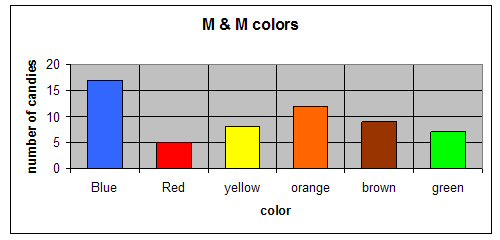
Discuss
Pictograph-using pictures rather than columns to make a graph.
Make a class pictograph of the color that showed up the most in
each package. (I used a circle di-cut and put a small white di-cut
“m” to make the circles look like M&M’s.) Each student attached
an M&M to the graph depicting the color that showed up the most
in their individual packages. Label x & y axis and put on a
title.

Discuss a map
key-Convert the class pictograph of the most common color of
M&M’s to a smaller scale graph using Scholastic Keys Max Count.
Show how to do this on projector. Assign students to then
convert their pictograph of the color of M&M’s in their
individual bags to a smaller scale graph using Max Count. What
is the most common color of M&M? Least common color?
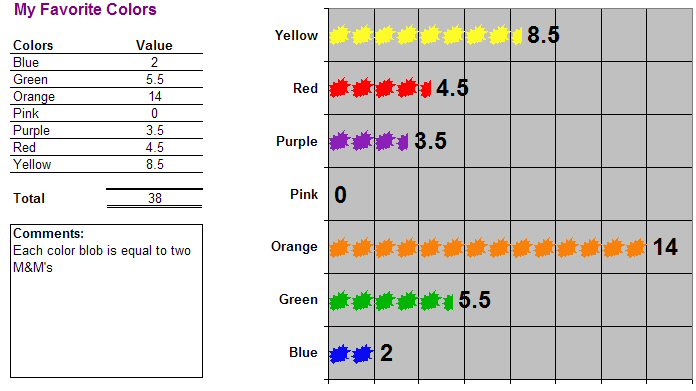
Max Count
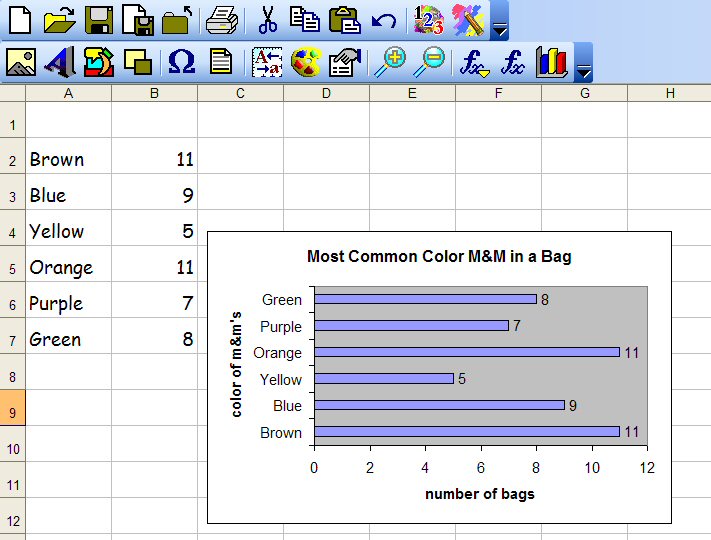
Max Count
Discuss bar
graphs-make a bar graph using the post it notes to make the
columns on the graph. Students are to write the number of M&M’s
that were in their package on their post it note. Label the x
axis and y axis and title. Discuss mode—the number that appears
most often depicts the mode of this set of data. Our mode was
56.
As
students finish their computer work they can do one of the
following activities: On the inside cover of your M&M folder
make as many sentences as you can with each word in the sentence
beginning with the letter M. (You may use in, of, on, and, with,
and off in your sentences) Example: Mary munches M&M’s on
Mondays. Complete worksheet titled M&M math—comparisons using
>,<,= with individual colors of M&M’s. Complete M&M Brain
Teasers WS. Assign students to work on The Checkout Counter was
(students complete a purchase order from the m&m on line store
and calculate subtotals, shipping charges, and total costs—I
have my students use calculators for this assignment) Read
Aloud—Have students choose one M&M to eat. Ask students what
color they chose and why. Read Dr. Seuss's Many Colored Days
book. Discuss how color has an affect on people’s moods and
feeling. Discuss color of clothing at a ballgame, funeral,
springtime, fall, etc. Science: Students are divided into groups
and by using the steps in the scientific process, students must
design an experiment to determine if one can taste color.
Students must determine a hypothesis, discuss the control
variable, explain the steps involved in the process and draw a
conclusion from their findings. Students record steps to the
experiment on the Kidspiration science experiment template. Upon
completion of the experiment template, we published our results
with Scholastic Keys Max Write.
Experiment
2—students follow the same steps to answer the following
question: “If a plain M&M and a peanut M&M are dropped from the
same height at the same time, which one will hit the ground
first? Students are graded on how well the steps to the
experiment are explained and how well they work together in a
group—remember “M&M’s make friends!” Our day concludes with a
drink and an M&M treat provided by our room parents.
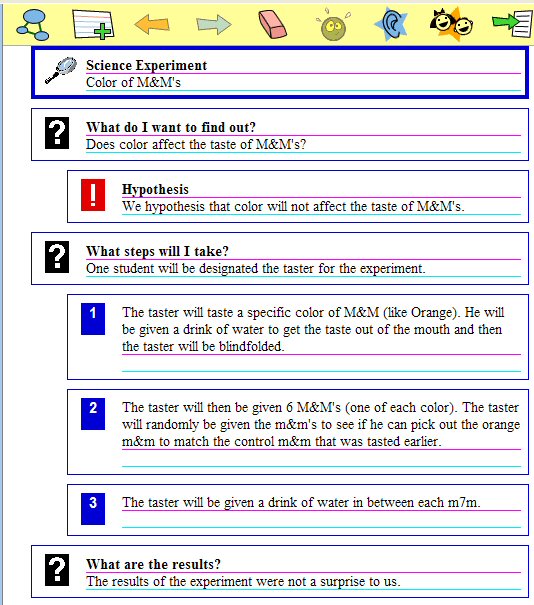
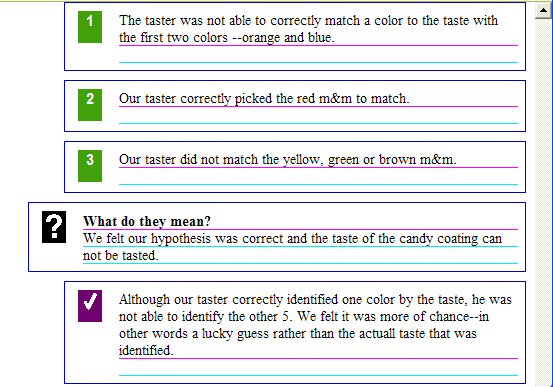
Kidspiration |